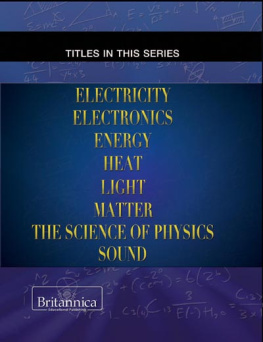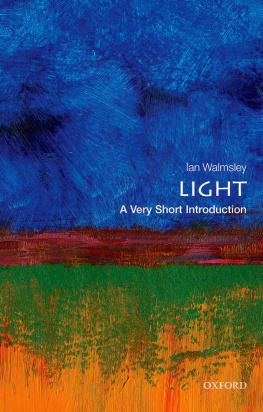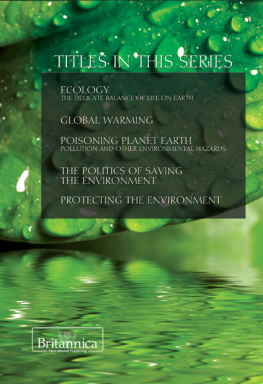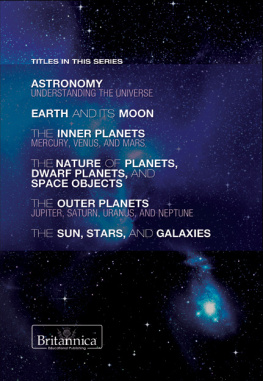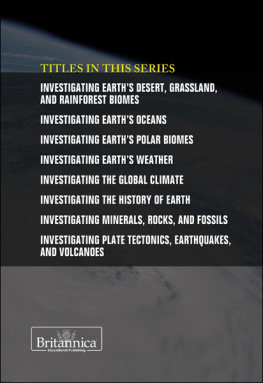LIGHT
INTRODUCTION TO PHYSICS
LIGHT
EDITED BY MICHAEL ANDERSON

Published in 2013 by Britannica Educational Publishing
(a trademark of Encyclopdia Britannica, Inc.)
in association with Rosen Educational Services, LLC
29 East 21st Street, New York, NY 10010.
Copyright 2013 Encyclopdia Britannica, Inc. Britannica, Encyclopdia Britannica, and the Thistle logo are registered trademarks of Encyclopdia Britannica, Inc. All rights reserved.
Rosen Educational Services materials copyright 2013 Rosen Educational Services, LLC.
All rights reserved.
Distributed exclusively by Rosen Educational Services.
For a listing of additional Britannica Educational Publishing titles, call toll free (800) 237-9932.
First Edition
Britannica Educational Publishing
J.E. Luebering: Director, Core Reference Group, Encyclopdia Britannica
Adam Augustyn: Assistant Manager, Encyclopdia Britannica
Anthony L. Green: Editor, Comptons by Britannica
Michael Anderson: Senior Editor, Comptons by Britannica
Andrea R. Field: Senior Editor, Comptons by Britannica
Sherman Hollar: Senior Editor, Comptons by Britannica
Marilyn L. Barton: Senior Coordinator, Production Control
Steven Bosco: Director, Editorial Technologies
Lisa S. Braucher: Senior Producer and Data Editor
Yvette Charboneau: Senior Copy Editor
Kathy Nakamura: Manager, Media Acquisition
Rosen Educational Services
Nicholas Croce: Editor
Nelson S: Art Director
Cindy Reiman: Photography Manager
Karen Huang: Photo Researcher
Brian Garvey: Designer, Cover Design
Introduction by Nicholas Croce
Library of Congress Cataloging-in-Publication Data
Light/edited by Michael Anderson.1st ed.
p. cm.(Introduction to physics)
In association with Britannica Educational Publishing, Rosen Educational Services.
Includes bibliographical references and index.
ISBN 978-1-61530-844-6 (eBook)
1. LightJuvenile literature. I. Anderson, Michael, 1972
QC360.L53 2013
535dc23
2012010241
Cover (burst), p. 3 iStockphoto.com/Michael Phillips; cover (equation) EtiAmmos/Shutterstock.com; pp. SkillUp/Shutterstock.com; remaining interior background image iStockphoto.com/Andrew Robinson
On pages 7:Aurora borealis. iStockphoto/Thinkstock
CONTENTS





INTRODUCTION
I ts hard to imagine a world without light. Most of us, however, take for granted just how complex and intriguing this form of energy is. This volume investigates the nature of light, from its basic behaviors such as reflection and refraction to its relationship to the concepts of space and time.
The properties of light have puzzled scientists for centuries. Isaac Newton believed that light was composed of particles. Christiaan Huygens believed it traveled in the form of a wave. Even up to the early 20th century, scientists could not explain why light conformed to both particle and wave theory. It was not until 1924 that Louis de Broglie put forth the idea that both theories were necessary to explain the properties of light.
Light is one of several forms of energy that together are known as electromagnetic (EM) radiation. The various forms of EM radiation are arranged on a spectrum according to their wavelengths, which fall within a very wide range. Light is the form of EM radiation that is visible to the human eye. It occupies a very narrow band within the broad EM spectrum, from about 700 nanometers (nm; billionths of a meter) down to about 400 nm. The other forms of EM radiation, which are invisible to the human eye, include gamma rays, X-rays, ultraviolet radiation, infrared radiation, and radio waves. In other words, the light we see when watching a sunset or reading a book is only a portion of the radiation that exists around us.
Without light, vision would be impossible. We see the objects around us, such as our friends faces or a dog running down the street, only when light rays bounce off those objects surfaces and travel to our eyes. The colors of those objects are a result of the wavelengths of the light waves that reach our eyes. Light of different wavelengths appears as different colors. For example, red light has a long wavelength, and violet light has a short wavelength. Normally all the wavelengths, or colors, travel together as white light, but white light separates into its individual colors when it strikes objects. When white light strikes a ripe tomato, for instance, mostly red wavelengths reflect off the tomato, while the other colors are absorbed. This causes the tomato to look red.
Another aspect of light that has proved central to the study of physics is its speed. Measuring the speed of light was a long-standing challenge for scientists. In 1905 Albert Einstein made a breakthrough. As part of his theory of special relativity, he put forth that the speed of light is the same for all observers. Since then, the speed of light has been considered a fundamental constant of nature. In Einsteins famous relativity equation, E=mc2, the speed of light (c) serves as a constant linking the formerly separate concepts of mass (m) and energy (E). The work of later scientists refined measurements of the speed of light, which was eventually defined at exactly 299,792,458 meters (186,282 miles) per second.
This volume explores the mysterious properties of light, from its physical characteristics to its intriguing behavior. It provides a strong foundation for the study of this crucial and complex form of energy, which fundamentally shapes our everyday lives and, on the grandest scale, provides a window on the structure of the universe.
CHAPTER 1
THE FUNDAMENTALS OF LIGHT
O ne of the most familiar and important forms of energy is light. Nothing is visible to humans when light is totally absent. But light is even more important for other reasons. Many scientists believe that millions of years ago light from the Sun triggered the chemical reactions that led to the development of life on Earth. Without light the living things now on Earth would be unable to survive. Light from the Sun provides energy for life on Earth. Plants change the energy of sunlight into food energy. When light rays strike a green plant, some of their energy is changed to chemical energy, which the plant uses to make food out of air and minerals. This process is called photosynthesis. Very nearly all living organisms on Earth depend directly or indirectly on photosynthesis for their food energy.
Some of the energy of sunlight is absorbed by Earths atmosphere or by Earth itself. Much of this energy is then changed to heat energy, which helps warm the planet, keeping it in the temperature range that living things have adapted to.
LIGHT AND ELECTROMAGNETIC RADIATION
Different kinds of light are visible to different species. Humans see light in what is called the visible range. It includes all the colors beginning with red and continuing through orange, yellow, green, blue, and violet. Some people can see farther into the violet region or the red region than other people. Some animals have a different sensory range. Pit vipers, for example, have sense organs (pits) that see rays that humans feel as heat. These rays are called infrared radiation. Bees, on the other hand, not only see some of the colors that humans see but are also sensitive to ultraviolet radiation, which is beyond the range visible to humans. So, though human eyes cannot detect them, infrared rays and ultraviolet rays are related to visible light. Instruments have been built that can detect and photograph objects by means of infrared rays or ultraviolet rays. X-rays, which can also be used to photograph objects, are also related to light.
Next page








